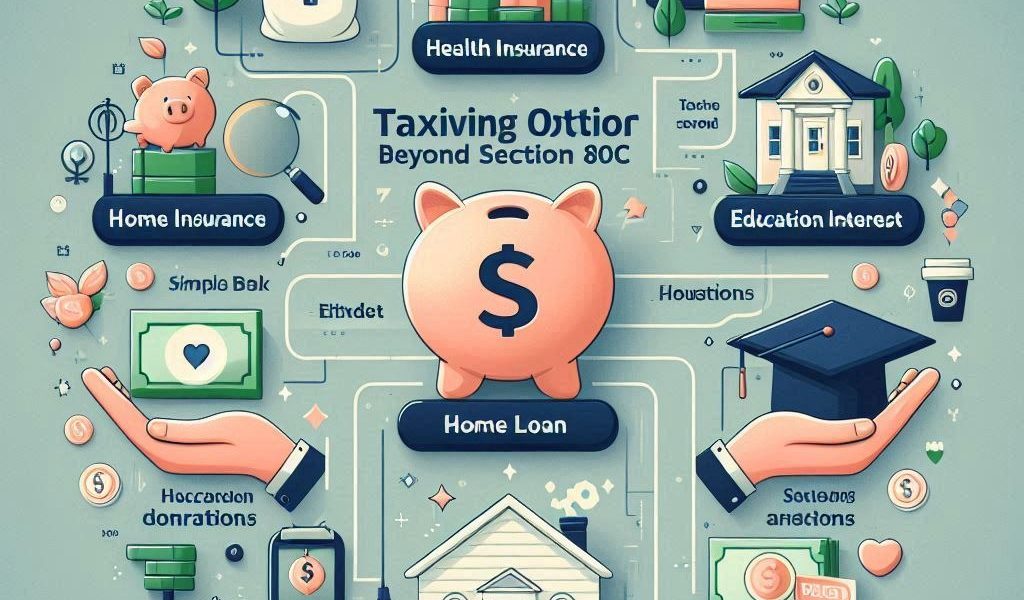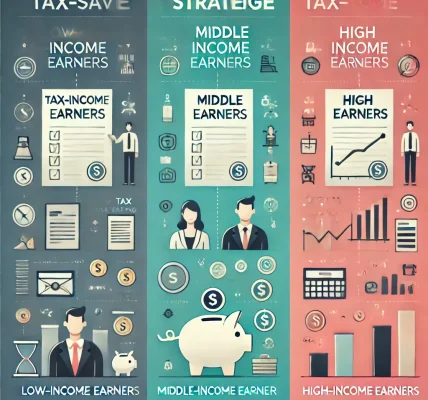Introduction
Most taxpayers in India are aware of Section 80C of the Income Tax Act, 1961, which allows deductions up to ₹1.5 lakh for investments in instruments like PPF, ELSS, NSC, and Life Insurance Premiums. However, if you have already exhausted the 80C limit, you can still reduce your tax liability through other sections of the Income Tax Act.
In this guide, we will explore the best tax-saving investment options beyond 80C, helping you legally optimize your tax savings and grow your wealth.
1. National Pension System (NPS) – Section 80CCD(1B)
What is NPS?
The National Pension System (NPS) is a government-backed retirement savings scheme that allows individuals to invest in a market-linked pension fund for long-term wealth accumulation and pension benefits.
Tax Benefits
- Additional deduction of ₹50,000 under Section 80CCD(1B) (over and above ₹1.5 lakh under 80C).
- Employer’s contribution up to 10% of salary (Basic + DA) is deductible under Section 80CCD(2) (not included in 80C limit).
Who Should Invest?
✅ Salaried employees seeking extra tax savings. ✅ Self-employed professionals planning for retirement.
2. Health Insurance Premium (Mediclaim) – Section 80D
What is Covered?
Under Section 80D, you can claim tax deductions on health insurance premiums paid for yourself, your family, and parents.
Tax Benefits
- Self, spouse, children – Deduction up to ₹25,000.
- Parents (below 60 years) – Additional ₹25,000.
- Parents (above 60 years) – Additional ₹50,000.
- Total possible deduction: Up to ₹1 lakh (if both taxpayer and parents are senior citizens).
Who Should Invest?
✅ Individuals looking for tax savings and health protection. ✅ Those supporting elderly parents with medical expenses.
3. Home Loan Interest – Section 24(b) and Section 80EEA
What is Covered?
Interest paid on a home loan is eligible for a tax deduction under Section 24(b) and 80EEA (for first-time homebuyers).
Tax Benefits
- Interest on home loan: Deduction up to ₹2 lakh under Section 24(b).
- Additional deduction of ₹1.5 lakh under Section 80EEA for first-time homebuyers (valid for affordable housing loans sanctioned before March 31, 2024).
Who Should Invest?
✅ Individuals planning to buy a new house. ✅ First-time homebuyers looking for extra tax savings.
4. Education Loan Interest – Section 80E
What is Covered?
Interest paid on an education loan for higher studies (for self, spouse, children, or a legal guardian) is deductible under Section 80E.
Tax Benefits
- Full interest paid on the loan is deductible (no upper limit).
- Deduction available for up to 8 years (starting from the year of repayment).
Who Should Invest?
✅ Students or parents taking an education loan. ✅ Individuals planning higher studies in India or abroad.
5. Rajiv Gandhi Equity Savings Scheme (RGESS) – Section 80CCG (Discontinued but Available for Existing Investors)
What is Covered?
RGESS was designed to promote equity investments for first-time investors in the stock market.
Tax Benefits
- 50% deduction on investment up to ₹50,000.
- Available for 3 consecutive years.
- Only available for investors with an annual income of ₹12 lakh or less.
Who Should Invest?
✅ First-time equity investors. ✅ Those who invested before RGESS discontinuation can continue claiming benefits.
6. Savings Account Interest – Section 80TTA and 80TTB
What is Covered?
Interest earned from savings accounts is partially tax-exempt under Section 80TTA (for individuals below 60) and Section 80TTB (for senior citizens).
Tax Benefits
- Up to ₹10,000 deduction on savings interest under 80TTA.
- Up to ₹50,000 deduction for senior citizens under 80TTB (including FD interest).
Who Should Invest?
✅ Individuals and senior citizens with interest income from savings accounts and FDs. ✅ Senior citizens looking for higher tax-free income.
7. Donations to Charity – Section 80G
What is Covered?
Donations made to approved charitable organizations and relief funds qualify for deductions under Section 80G.
Tax Benefits
- 100% deduction for donations to specific government relief funds.
- 50% deduction for donations to other eligible charities.
Who Should Invest?
✅ Individuals wishing to support social causes while saving taxes. ✅ High-income earners looking to reduce taxable income legally.
8. Rent Paid by Self-Employed Individuals – Section 80GG
What is Covered?
Self-employed individuals and those not receiving HRA can claim deductions on rent paid.
Tax Benefits
- Deduction is lower of the following:
- ₹60,000 per year.
- 25% of total income.
- Rent paid minus 10% of total income.
Who Should Invest?
✅ Self-employed individuals paying house rent. ✅ Employees not receiving HRA.
Conclusion
Beyond Section 80C, there are multiple ways to reduce tax liability while building wealth. Whether through NPS, health insurance, home loans, education loans, donations, or interest exemptions, strategic tax planning can help maximize savings.
Key Takeaways:
✅ NPS provides an extra ₹50,000 deduction beyond 80C. ✅ Health insurance saves tax up to ₹1 lakh under 80D. ✅ Home loan interest allows tax deduction up to ₹3.5 lakh (80EEA + 24(b)). ✅ Education loan interest is fully deductible for 8 years under 80E. ✅ Savings and FD interest is tax-free for senior citizens up to ₹50,000. ✅ Donations to charity can help reduce tax liability.




